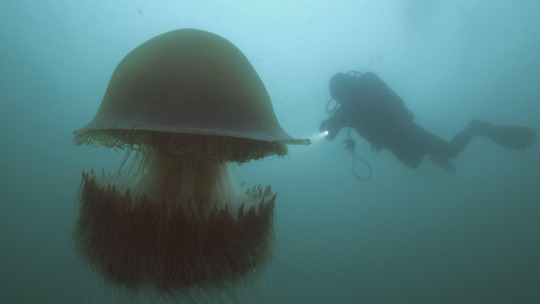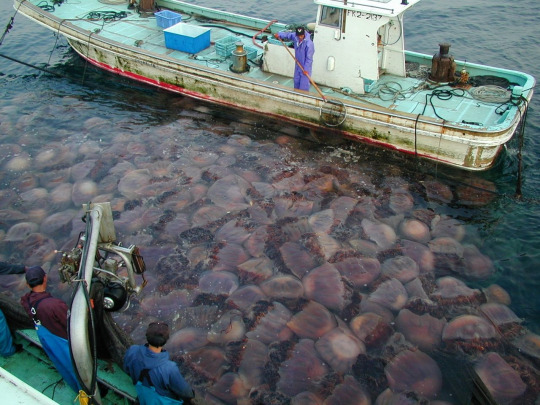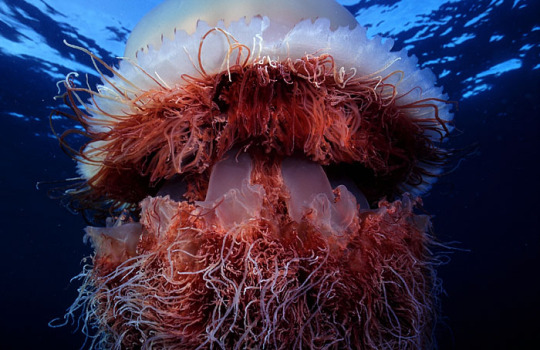#n. nomurai
Explore tagged Tumblr posts
Text
Daily Jellyfish #3 - Nemopilema nomurai
Nemopilema nomurai (Animalia; Cnidaria; Scyphozoa; Rhizostomeae; Rhizostomatidae) AKA 'Nomura's Jellyfish'.


© PBS LearningMedia
N. nomurai are known to grow up to 2m in diameter, and weigh up to 200kg. They are the second largest known jellyfish in the world, just trailing behind Cyanea capillata (Lions Mane Jellyfish), and can grow from the size of a grain of rice to their full size within six months.
Supposedly, they live in a depth range of about ~0-176m in the Epipelagic (Sunlight) Zone. Primarily, they are found in the waters between China and Japan - most notably the Yellow and East China seas.

© Y. Taniguchi
For the last ~20 years, population blooms in N. nomurai have been increasing greatly - causing great economic damage to Japanese fisheries. To combat these overpopulation blooms, recent research has sought to find ways to convert into resources (i.e. food, medicine, and agricultural tools).
When under attack or threat, N. nomurai will release billions of sperm or eggs which then attach to rocks and corals. These then grow into even more jellyfish (sometimes millions) at later times, making removal of these jellyfish very difficult.

© Hushigi
Feeds mostly off of zooplankton and larger fish, to which they poison for easier consumption, and devour them with their hundreds of microscopic mouths.

Masterlist! // Honestly such a haunting jellyfish, the sheer size of them is absolutely terrifying. I love their stinging tentacles! The way they billow out is beautiful <3

#informative#info dump#marine science#marine biology#marine life#nemopilema nomurai#n. nomurai#nomura's jellyfish#jellyfish#jellies#daily jellyfish#personal project
8 notes
·
View notes
Text
This giant jellyfish's venom is so complex, scientists aren't sure what makes it deadly
https://sciencespies.com/nature/this-giant-jellyfishs-venom-is-so-complex-scientists-arent-sure-what-makes-it-deadly/
This giant jellyfish's venom is so complex, scientists aren't sure what makes it deadly
Somewhere out there in the deep lies a huge jellyfish, just waiting to unleash a complex cocktail of venom via its many long tentacles.
Weighing up to 200 kilograms (440 pounds), the giant jellyfish Nemopilema nomurai, more commonly known as Nomura’s jellyfish, is one of the largest jellyfish species in the world, and it stings hundreds of thousands of unsuspecting swimmers in China, Korea, and Japan every year.
When stings occur, the creature’s venom causes an immediate and severe pain, followed by redness and swelling. In rare cases, stings can lead to shock, severe injury, or even death.
Ultimately, we still don’t know what makes this creature’s venom so dangerous (being evidently deadly for some people), but we’re getting closer to finding the truly lethal component.
In a new study, scientists sat down to analyse this incredible venom through genomic sequencing, transcriptomics, and proteomics. In doing so, they discovered an incredibly complex mixture of over 200 sting-related toxins, each of which could be targeting specific organs or harming bodily systems.
“Although we tried to purify the lethal toxin(s) from the venom of N. nomurai, it was excessively difficult to separate them from other proteins individually,” the authors explain in their new paper.
In other words, these toxins are so complex, it’s hard to tease out all the individual factors at play – at least, without resorting to other kinds of experiments.
In the study, the team also cut and froze fresh tentacles straight from a live jellyfish, before centrifuging them to collect nematocysts – a specialised cell in jellyfish that contains a coil of venom.
Carefully extracting the venom’s proteins and separating them into different groups, the researchers injected each protein fraction into mice, to see which ones died.
The results highlight a group of 13 toxin-like proteins that have potentially fatal consequences – some target cell membranes, others target potassium channels, while others have blood-clumping effects.
On a larger scale, the consequences include vascular congestion of the heart, vascular degeneration, cell death in the liver, changes in the kidneys, and inflammation of the lungs.
Analysing the mice post mortem, researchers found pulmonary infection and edema were the most likely cause of death, which is consistent with human reports.
Still, the authors admit it’s difficult to say for sure how each of these individual toxins actually kills animals, suggesting they could be working in tandem.
Better understanding this brew of toxins might help us develop an antidote for this jellyfish’s sting, but first we’d need to explore whether these potentially lethal toxins are equally dangerous to humans.
The study was published in the Journal of Proteome Research.
#Nature
0 notes
Text
Daily Jellyfish Masterlist (A-Z):

A: B:
✰ Bathykorus bouilloni (Day #2)
C: D: E: F: G: H: I: J: K: L: M: N:
✰ Nemopilema Nomurai (Day #3)
O: P: Q: R: S:
✰ Stygiomedusa gigantea (Day #1)
T: U: V: W: X: Y: Z:

5 notes
·
View notes